Christine Valters Paintner's Blog, page 77
September 7, 2019
Monk in the World: Hospitality 1 – A Love Note from Your Online Abbess
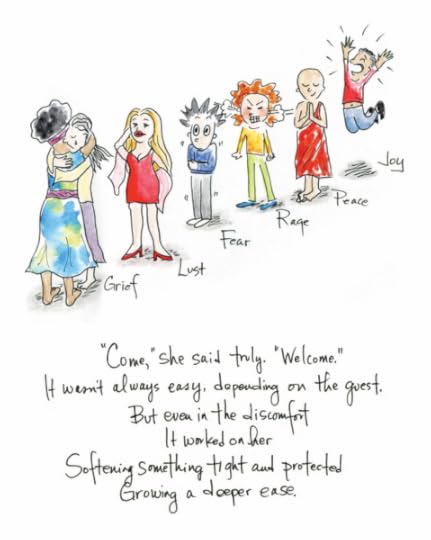 Dearest monks, artists, and pilgrims,
Dearest monks, artists, and pilgrims,
During this Jubilee year of sabbatical we are revisiting our Monk Manifesto by moving slowly through the Monk in the World retreat materials together every Sunday. Each week will offer new reflections on the theme and every six weeks will introduce a new principle.
Principle Two: I commit to radical acts of hospitality by welcoming the stranger both without and within. I recognize that when I make space inside my heart for the unclaimed parts of myself, I cultivate compassion and the ability to accept those places in others.
"All guests who present themselves are to be welcomed as Christ, for him himself will say: I was a stranger and you welcomed me."
—Rule of St. Benedict 53:1
St. Benedict invites us to welcome in each stranger we encounter as the face of Christ in our lives. Those people who make us uncomfortable or we dislike are especially included. I also believe that Benedict meant to extend this hospitality within ourselves and seek out the stranger who knocks within on our hearts – that part of ourselves that has been neglected or shut out. This inner and outer act of hospitality are intimately connected. As we grow in compassion for the places within which challenge us, we are able to extend that compassion toward others. The more we grow intimate with our own places of weakness or unlived longings, the more we can accept these in others.
When people in our lives stir a strong reaction in us, often it is because we are seeing our own shadow side being reflected back to us. Being curious about our response opens us up to greater interior freedom as we discover the inner places we have neglected.
Monastic spirituality calls us to see everything and everyone – including ourselves – as holy. The tools of the kitchen are to be regarded as sacred vessels. The places in our heart where we wrestle are to be embraced with kindness. The person who irritates us or makes us feel fearful is a window into how God is at work in our lives. Being a monk in the world means that there are no more divisions between sacred and secular.
With great and growing love,
Christine
Christine Valters Paintner, PhD, REACE
Art work © Kristin Noelle
Text: "Come," she said truly. "Welcome." It wasn't always easy, depending on the guest. But even in the discomfort it worked on her softening something tight and protected growing a deeper ease.
September 5, 2019
Notes from the Jubilee: Ancestral Pilgrimage to Latvia
During this sabbatical year I have several ancestral pilgrimages planned and we are traveling back now from the first one to Latvia. A few months ago I asked Olga Tomchin of Genealogy Yenta to help me with some research and she found an article online about an oak tree that was planted in 2017 for my great grandfather. It turns out that he was the first Chief Justice of the Latvian Supreme Court when the independent state was formed after World War I and for their centenary celebration they decided to honor his memory in this way.
My father was born in Riga and I knew his fatherline was Latvian. John and I had even visited Riga ten years ago, a beautiful city. But I didn't know that my great grandfather grew up in the village of Kuldiga, attended law school at Moscow University, and then went on to play such a significant role when Latvia gained freedom for the first time. "The Latvians are looking for you," Olga wrote in her note to me with the article and sure enough it said that they were seeking descendants of Kristaps Valters. I emailed to see if I could come visit and got a swift enthusiastic reply.
We started our trip by going first to Kuldiga, a really beautiful and charming town with many preserved old wooden homes and a gorgeous park and river with waterfall. There we were driven out to the cemetery where my great grandfather is buried, along with his wife, his brother, his father, and other relatives I have yet to place in the tree. I had never been there before and it was really moving to stand in this place of ancestral remembrance for the first time knowing it had been waiting for me. Just down the road is the ruins of his house, all that is left after a fire is the brick and stone foundation on a wide expanse of farmland. He and his father, and father's father were all farmers, perhaps even further back than that. I was able to stand within the old structure and imagine their lives, to look out at their vista.
In the center of town is a beautiful park with a series of moving statues by a Latvian artist. There is also a young oak tree, planted less than two years ago, along with a stone from my great grandfather's house carved with his name into it. Again I was really moved by this potent symbol of his memory and how his contributions continue to flourish.
We then went on to Riga where we were invited to the Supreme Court building and were greeted by the current Chief Justice who was gracious enough to take a few minutes to welcome us, offer gratitude for the memory of my great grandfather, and gift us with some mementos. Rasma Zvejniece (along with translation provided by Iveta Jaudzema who had helped us organize everything) was my original contact and she went through a binder full of research she had done on Kristaps Valters' life, and said how glad she was to finally make a connection to his family. She showed us around the building, we went into the courtroom and I got to sit for a few minutes in the current Chief Justice's chair, and we saw their museum where my great grandfather's memory is perpetuated. I also brought some family photos of him I was grateful to find in my collection to donate for their use.
It has been a powerful week. My father and grandfather fled Latvia in 1944 and they never returned because of Soviet occupation. My great grandfather died later that year after returning to his childhood home of Kuldiga. Growing up my father always identified more strongly with his mother's Austrian side and we visited Vienna often. After that initial finding of the article, I worked with another researcher in Latvia who helped me uncover names and dates for the previous two generations than what I had already known.
There are lots of layers for me still to uncover, much to ponder. I feel like a door has opened within me to this whole Latvian lineage, an invitation from the ancestors to come to know their gifts for me.
I have been doing this ancestral work for many years now and even when I think there is nothing new left to discover, this whole vein of riches is opened. I am sure I will be back to Latvia again soon.
The day after visiting the court an article was published about our trip to the Riga Supreme Court. It is written in Latvian but there are a couple of photos included. This is the original article we found about the oak tree planting (in English).
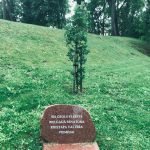

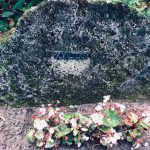

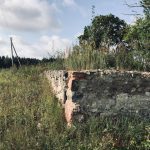
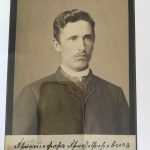
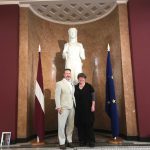
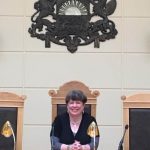
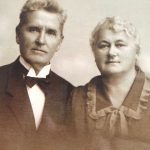
September 3, 2019
Monk in the World Guest Post: Cathy Warner
I am delighted to share another beautiful submission to the Monk in the World guest post series from the community. Read on for Cathy Warner's reflection "Two and a Half Horsepower Zen."
A few months ago I ran an extension cord across the backyard, plugged in my mini-wood chipper, dragged downed limbs and small dead trees into a pile, stood in a sunny spot, and fed branches one at a time into the hopper where a whirling blade chipped, shaved, bit, and spit the cedar, rhododendron, and maple into a heap of garden muesli.
Often when gardening or cleaning house, I listen to audiobooks trying to squeeze literature into my chores. The chipper was loud and I didn't want to scavenge for my noise-cancelling headphones, so in the words of James Taylor's "Millworker," it was "me and my machine for the rest of the morning, the rest of the afternoon," and for the next few days since my husband was out of town. Like the millworker in the song, I found that running the chipper wasn't easy or hard. But it also wasn't boring.
The more I used the chipper, the more familiar I became with its operation—straight well-dried branches no more than an inch thick buzzed through easily. Berry canes and green leaves caught in the blade cutting the motor out, and I had to disassemble the feeder, empty it, and start over. Rhododendrons were tricky, too, and I squeezed their forked branches together, feeding with just enough pressure to hear the blade whine and prevent the ends from tumbling in the hopper like the last kernels of un-popped corn.
It was rewarding, making a dent in the nursery graveyard. I didn't begrudge the former owner's mess. He was almost ninety when he moved out and tending half an acre is hard work.
Warmed by the sun, surrounded by living cedars and pine, mulching dead trees, I developed a rhythm as I lifted a branch, fed it to the machine, listened for the cadence of the shredding wheel, and repeated the motions until there was nothing else in the world. Just me, my machine, and the material I fed it—a loop of action and energy—the distinctions between plant, human, and machine hazy and unimportant. I lost track of time and place. I wasn't thinking about how many branches were left in my pile and when I'd have to drag more over. I wasn't thinking about lunch or calling my husband later. I was simply and fully in the present moment.
I don't know how long I was in that frame of non-mind. I only recognized I'd been in it when my ego drifted back into consciousness, and I thought, "Wow, I was really in the zone." As soon as I thought about being in that zone, it evaporated. Thoughts came crashing back like breakers on a beach, a tidal onslaught that wouldn't stop. I thought about how cool my Zen moment was, how it felt like when I am truly able to surrender myself to prayer, eyes closed, holding the hand of my prayer partner, the ticking of her grandfather clock heralding a holy presence waiting to enter at the slightest invitation.
This was the first time I was transported by physical labor and I thought that losing track of time and space must be what happened to my husband all those nights he was late for dinner because of a home improvement project. And I thought about how understanding I would be now that I'd shared his experience. And, since I was blogging about our move to this fixer-upper, I thought that I should blog about the spiritual side of home improvement.
As responses to the wonder of my woodchipping Zen whipped through my mind, my attention to both machine and body waned. The motor screeched as branches tangled and stuck in the hopper. I yanked at them and felt an angry twang and twinge of muscles across my back.
My inattention sidelined me for days as I alternated between ice pack and heating pad, unable to work or even blog. But in those days of moving gingerly and negotiating pain, I often found myself in the Zen-like consciousness both the woodchipper and prayer evoked. I floated in a whittled down world that consisted only of body and breath—a world that contained nothing but the moment and the opportunity to practice stillness within that blessed moment.
 Cathy Warner is a writer, editor, teacher, home renovator, and realtor who lives alongside Washington's Hood Canal. Author of two books of poetry Home By Another Road, and Burnt Offerings, her fiction, short memoir, and essays have appeared in dozens of print and online journals. Find her at CathyWarner.com.
Cathy Warner is a writer, editor, teacher, home renovator, and realtor who lives alongside Washington's Hood Canal. Author of two books of poetry Home By Another Road, and Burnt Offerings, her fiction, short memoir, and essays have appeared in dozens of print and online journals. Find her at CathyWarner.com.
August 31, 2019
Monk in the World: Reflection Questions and Blessing (Silence and Solitude) ~ A Love Note from Your Online Abbess
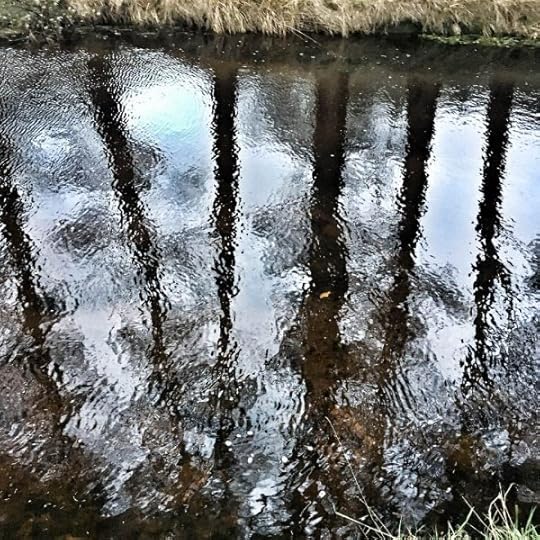 Dearest monks, artists, and pilgrims,
Dearest monks, artists, and pilgrims,
During this Jubilee year of sabbatical we are revisiting our Monk Manifesto by moving slowly through the Monk in the World retreat materials together every Sunday. Each week will offer new reflections on the theme and every six weeks will introduce a new principle.
Principle One: I commit to finding moments each day for silence and solitude, to make space for another voice to be heard, and to resist a culture of noise and constant stimulation.
Spend some time in quiet reflection on the following questions. You might take out your journal and pen and free-write in response to see what you discover.
What is one thing in your life you could let go of for the next few days to make space for the grace of silence?
In what ways do you experience silence as a presence and fullness in your life rather than the mere absence of noise?
Closing Blessing from Christine
Holy Giver of Silence
Sustain me in these sacred spaces
and embrace me with your presence.
I pause each day to listen to your whisperings
which call me to a deepened way of being.
I enter the quiet and ask for the courage to respond
to what I discover in that tabernacle of time.
With great and growing love,
Christine
Christine Valters Paintner, PhD, REACE
Photo © Christine Valters Paintner
August 27, 2019
Featured Poet: Joel McKerrow
Last spring we launched a series with poets whose work we love and want to feature and will continue it moving forward.
Our next poet is Joel McKerrow whose work is inspired by liminal spaces. You can watch Joel's poem videos and read more about the connections he makes between poetry and the sacred.
Joel McKerrow- WIND (with Spike Mason). from Joel McKerrow on Vimeo.
Themes of His Work
I have just finished working on a book, a creative non-fiction all about the spiritual journey. Its called WOVEN: A Spirituality for the Dissatisfied and is being published in November. So a lot of my focus has been on taking the stories of my life when everything has crumbled and the doubt has come and the wrestle and the struggle are at their most intense and working out how to articulate these often indescribable moments. How to give voice to the deep longings that stir in those liminal times. This would be a major theme- the liminal, between that which has finished and that which has not yet begun.
Poetry and the Sacred
When I sit down at my table to write. I am never really just writing. I am engaging in ritual. From the pouring of the tea, to the unfolding of my antique writing table, to the moment the words begin to flow, or more often, the moment I drag them out of myself. This is all ritual. It is all a process of slowing down from the chaos of my life and choosing to be present to myself and to the story that wants to come out of me and also to the sacred. It is in this three way intersection of self, story and sacred that I consider the words that come out of me to be nothing but prayer. And if my words are prayer then my poetry is worship. It is an unfolding of myself and a giving of myself. It forces me to be fully truthful and authentic. It forces me to name my inner world even when I'd rather not. It is in the naming and the owning of my reality that I can then find the surrender of this reality through writing it down, giving it over. There is no difference between my prayer and my poetry.
About Joel McKerrow
Joel McKerrow is an award winning writer, speaker, educator, creativity specialist and is one of Australia's most successful performance poets. Based out of Melbourne, Australia he has seven published works of poetry, is the Artist Ambassador for the aid and development organisation 'TEAR Australia', was the third ever Australian representative at the Individual World Poetry Slam Championships and is a co-founder/host of the The Deep Place: On Creativity and Spirituality Podcast. Joel teaches on creativity and spiritual formation all over the world and has just opened up registration to his first ever ONLINE course - A Clearing in the Forest: An online writing course for cultivating artistry and self growth through the creative process.
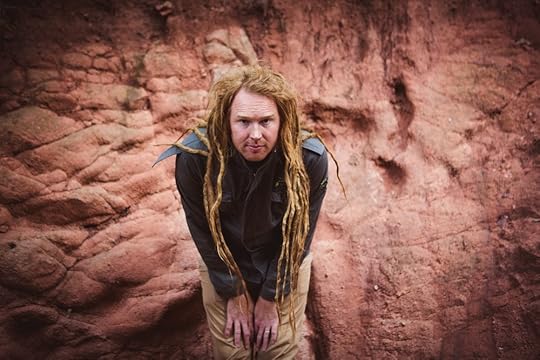
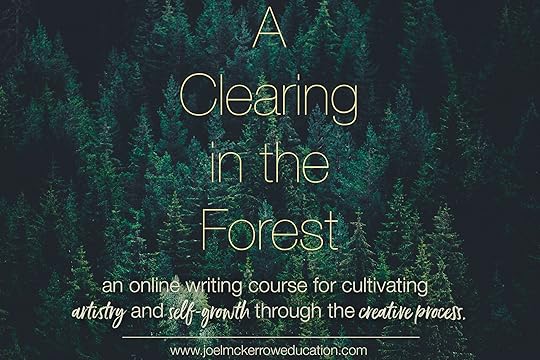
Work
You can find Joel's writing, videos, music, teaching, etc at:
Website - JoelMckerrow.com
Podcast - TheDeepPlacePodcast.com
Online Course - JoelMcKerrowEducation.com

Dreaming of Stones
Christine Valters Paintner's new collection of poems Dreaming of Stones has just been published by Paraclete Press.
The poems in Dreaming of Stones are about what endures: hope and desire, changing seasons, wild places, love, and the wisdom of mystics. Inspired by the poet's time living in Ireland these readings invite you into deeper ways of seeing the world. They have an incantational quality. Drawing on her commitment as a Benedictine oblate, the poems arise out of a practice of sitting in silence and lectio divina, in which life becomes the holy text.
[image error]
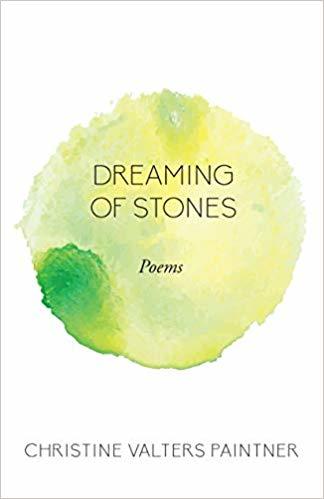
August 24, 2019
Monk in the World Suggestions for Practice (Silence and Solitude) ~ A Love Note from Your Online Abbess
 Dearest monks, artists, and pilgrims,
Dearest monks, artists, and pilgrims,
During this Jubilee year of sabbatical we are revisiting our Monk Manifesto by moving slowly through the Monk in the World retreat materials together every Sunday. Each week will offer new reflections on the theme and every six weeks will introduce a new principle.
Principle One: I commit to finding moments each day for silence and solitude, to make space for another voice to be heard, and to resist a culture of noise and constant stimulation.
Just for today claim a window of time – even ten minutes is enough to begin – and rest into an experience of stillness. Connect gently with your breath, breathing in the life-sustaining breath of the spirit, breathing out and releasing whatever distracts us from this moment. As thoughts or anxieties arise, gently release them and return to this moment. The invitation is toward both an outer and inner silence. Notice the way silence nourishes you and consider ways to give yourself this gift each day.
With great and growing love,
Christine
Christine Valters Paintner, PhD, REACE
Photo © Christine Valters Paintner
August 20, 2019
Monk in the World Guest Post: Anne Knorr
I am delighted to share another beautiful submission to the Monk in the World guest post series from the community. Read on for Anne Knorr's reflection,"Ebb Tides."
Walking along the rocky shoreline during ebb tide, an eighty-five year old man named Billy Proctor can often be seen in tall black rubber boots looking for treasures washed ashore. It is a ritual he has observed since childhood and over the years he has collected a myriad of hidden jewels; large aqua-marine glass buoys, chiseled arrow heads, ancient metal jewelry from the "original people" as he calls them, colorful bottles of all shapes and sizes, China dishes, and even a scientifically verified meteorite. He was one of the most delightful characters I met in the Broughton Islands on my way north to Alaska with my husband aboard our boat, Mystic Dancer. With an infectious smile and tales a mile long of his life on this rugged piece of land and the surrounding sea, he welcomes travelers passing through the archipelago. He is actually quite a legend in the area having lived on the islands most of his life earning a living by fishing, trapping, and logging.
Hundreds of visitors pass through his quaint museum at Echo Bay and are greeted with a warm welcome and of course a story or two. His museum includes a replica of a trappers cabin entirely built from one cedar tree. Inside the main building, neat rows of shelves and glass cases display his wares. Rays of sunlight shine through paned windows lighting up the countless bottles stacked on a high shelf – amber, deep green, and sea blue. I was touched by this man's ability to find intriguing cast-offs covered in the muck and sand on the ocean floor and his patience in searching out whatever treasure might appear, each trinket holding the remnant of an unknown story. The word treasure means, "to have great value," but it also carries with it a sense that it is not easily obtained.
Ebb tides bring out hunters of another kind, as well. Bear comb the shores in search of clams, crow and bald eagles hover over the mud flats looking for morsels to nourish themselves, and muscles cling to the edges of rocks, their black shells exposed by the receding water. When I consider the ebb-tide experiences in my life, it is nice to think there is something of value to be discovered in dark and mucky places. Many of the most important lessons I've learned in life and self-awareness have come as the result of difficult experiences, the one's where I've failed miserably, embarrassed myself, or encountered devastating grief. After my brother's death, I learned I am more resilient than I realized, that happiness is possible even after an overwhelming loss, and that a reservoir of compassion is available within myself I hadn't known was there.
But like Billy Proctor, I had to walk along the barren shore many mornings without any treasure to be found – accepting the current bleakness in my heart and the random timing of when something of value would wash ashore, all the while knowing the walking and the looking were necessary parts of the process. Words from a verse in the Bible would often play in my mind, I will give you the treasures of darkness and hidden wealth in secret places, like a mantra promising my heart future blessings. My son had a similar ebb-tide insight while studying abroad in Ireland. He felt completely displaced and terribly homesick, yet he knew he needed to stay where he was. In the four months he was away I noticed a palatable shift in his demeanor. He exuded a new confidence in himself that replaced the tentativeness he carried with him to Ireland. It was as if he'd left home a boy and returned a man. He had found an inner resource, a solid place to stand amidst the turmoil. I find wisdom in the rhythms of nature; like the ebb and flow of the ocean tide, the daily rising and falling of the sun, and the revolving seasons, my life is continually moving and transforming too. And somehow that is reassuring. So now when the ebb tides come into my life again, as they surely will, I'll take my cue from Billy Proctor and patiently comb the terrain with an eye out for the hidden treasure awaiting my discovery.
 Anne Knorr is an architect, spiritual director and author of the book Sacred Space at Home that explores the connection between architecture and spirituality. She lives in Boulder, Colorado with her husband Bill and spends several months a year on their boat, Mystic Dancer, exploring the coastal waterways of the Northwest.
Anne Knorr is an architect, spiritual director and author of the book Sacred Space at Home that explores the connection between architecture and spirituality. She lives in Boulder, Colorado with her husband Bill and spends several months a year on their boat, Mystic Dancer, exploring the coastal waterways of the Northwest.
August 18, 2019
Poetry and the Sacred Garden of the World Participant Poems: Carol Everson
Last spring a sweet gather of creative souls joined with us for our retreat Poetry and the Sacred Garden of the World in Chartres, France. We had a wonderful group with participants and I am delighted to share some of their poems. Pour a cup of tea and savor for a while.
From Carol Everyone
Ode to Nurses' Aides
Here's to the handler of bedpans
and colostomy bags
whose fingernails grow
fertilized by feces.
To the bather and dresser
and undresser and put-to-bedder
who wishes sweet dreams
to the departing.
To the listener to stories
told a thousand times,
who knows what really matters
are memories of past joys.
To the humble servant
whose minimum wage
supports, or almost supports,
a family of five.
Blessings on thee, humble servant.
May you receive as much as you give,
and come to know God's glory
in the everyday tasks of taking care.
The Zoo
When she was very small
we took her to the zoo.
In her stroller we pointed
her towards zebras and elephants,
wanting to amuse her with
the rare, the exotic.
But she was uninterested.
She wanted to see,
and to touch,
the pigeons that gathered round her stroller,
hoping for the crumbs
that always followed in her wake.
They were common pigeons,
but still exotic to her in her holy innocence.
Lord, give me the innocence to see
your nearby, everyday people,
as more interesting, more exotic,
than zebras or elephants.
 Carol Everson is a retired City of Seattle employee. She worked mainly in the Finance area, consistent with her training as an economist. When she turned 50, she decided that she didn't have to be "good" at something to enjoy doing it. It was then that she began to explore her creative side through writing poetry and painting in watercolor. She loves the serendipity of both and enjoys the fun of discovery of what is being created!
Carol Everson is a retired City of Seattle employee. She worked mainly in the Finance area, consistent with her training as an economist. When she turned 50, she decided that she didn't have to be "good" at something to enjoy doing it. It was then that she began to explore her creative side through writing poetry and painting in watercolor. She loves the serendipity of both and enjoys the fun of discovery of what is being created!
Both of the poems here began as exercises in the June poetry writing workshop with Christine in Chartres, France.
August 17, 2019
Monk in the World Guided Meditation by Christine (Silence and Solitude) + AUDIO ~ A Love Note from Your Online Abbess
Dear pilgrims, monks, and artists,
During this Jubilee year of sabbatical we are revisiting our Monk Manifesto by moving slowly through the Monk in the World retreat materials together every Sunday. Each week will offer new reflections on the theme and every six weeks will introduce a new principle. This week we pray Lectio Divina with a text from Psalms. You can listen an audio recording of the practice below.
We will be praying with this text: Be still and know that I am God – Psalm 46:10
https://abbeyofthearts.com/blog/wp-content/uploads/2019/08/1-Silence-Monk-in-the-World-lectio-divina.mp3
First Movement – Lectio: Settling & Shimmering
For now, find a comfortable position where you can remain alert and yet also relax your body. Bring your attention to your breath and allow a few moments to become centered. If you find yourself distracted at any time, gently return to the rhythm of your breath as an anchor for your awareness. Allow yourself to settle into this moment and become fully present.
Read the line from the Psalms once or twice through slowly and listen for a word that feels significant right now, is capturing your attention even if you don't know why. Gently repeat this word to yourself in the silence.
Second Movement – Meditatio: Savoring & Stirring
Read the text again and then allow the word or phrase which caught your attention in the first movement to spark your imagination. Savor the word or phrase with all of your senses, notice what smells, sounds, tastes, sights, and feelings are evoked. Then listen for what images, feelings, and memories are stirring, welcoming them in, and then savoring and resting into this experience.
Third Movement – Oratio: Summoning & Serving
Read the text a third time and then listen for an invitation rising up from your experience of prayer so far. Considering the word or phrase and what it has evoked for you in memory, image, or feeling, what is the invitation? This invitation may be a summons toward a new awareness or action.
Fourth Movement – Contemplatio: Slowing & Stilling
Move into a time for simply resting in God and allowing your heart to fill with gratitude for God's presence in this time of prayer. Slow your thoughts and reflections even further and sink into the experience of stillness. Rest in the presence of God and allow yourself to simply be. Rest here for several minutes. Return to your breath if you find yourself distracted.
Silence also has an integrative function. Lectio divina can stir up a great deal of images and symbols which speak to the new thing being birthed within us. In this fourth movement we recognize the need to step back and simply be with what is happening in us, releasing our desire to be actively working on it, and allow it to ripen slowly. We enter the wisdom of night, the place where we can honor that which is nameless within us, that which is still seed and not blossom. We release all of our thoughts and desires and striving and simply rest in the presence of the One Who Is already there with us in the sacred space of our hearts.
Closing
Gently connect with your breath again and slowly bring your awareness back to the room, moving from inner experience to outer experience. Give yourself some time of transition between these moments of contemplative depth and your everyday life. Consider taking a few minutes to journal about what you experienced in your prayer.
With great and growing love,
Christine
Christine Valters Paintner, PhD, REACE
August 13, 2019
Featured Poet: Marjorie Maddox
Last spring we launched a series with poets whose work we love and want to feature and will continue it moving forward.
Our next poet is Marjorie Maddox, whose work focuses on the intersection of body and spirit. You can hear Marjorie reading her poem "Prayer" below and read more about the connections she makes between poetry and the sacred.
https://abbeyofthearts.com/blog/wp-content/uploads/2019/08/Prayer-by-Marjorie-Maddox.m4a
And the Topic for Today Is Environmentalism . . . .
Teaching "God's Grandeur"
More politically correct than divine grandeur,
it too flames out in this small Pennsylvania town
where fracking hijacks the headlines. Good reason
and good enough to bring the state students trodding
heavily into a poem piled high with God and earth,
with "responsibilities" they hear each morning
as the gas industry trucks rattle past our windows,
their tired drivers knowing nothing
of iambic pentameter or sestets but much
about food on the table, a steady job.
The freshmen, eager now,
blurt out dilemma, paradox, instress—
and all those other new-sounding ideas
suddenly connected to their lives,
their parents, the sonnet
they think was written last week,
even with its 19th century,
sound-packed syllables they don't get
until slowing down, thinking.
And so, after playing with light, foil, sound;
the way trade "sears," "blears," and "smears";
and how and why shoes separate us from ground,
we detour to Genesis, Cat Stevens, and a heavy metal rendition
that almost drowns out Hopkins with bass.
All this before rounding the terrain-raked bend
to solution, which is what—they are surprised to discover—
we all most want: the eloquent octet, the bright wings,
the ah! that opens the mind to talk
at long last, about the holy.
Previously published in True, False, None of the Above (Poiema Poetry Series and Illumination Book Award Medalist)
Themes of Her Work
I write poetry, fiction, creative nonfiction, and children's literature and address such diverse topics as baseball, my father's unsuccessful heart transplant, art, identity, living in an unsafe world, and the writing and teaching of literature. And yet—because faith is a central component of who I am—much of my work focuses on the intersection of body and spirit.
In my current book project, Seeing Things, I address memory within several parent/child relationships, including the beginning stages of my mother's dementia and my daughter's health issues. The manuscript also examines the ways we distort or preserve memory, define or alter reality, see or don't see those around us. I look forward to learning—through poetry and God's grace—what I will discover along the way.

Rocking Chair Hymn
And praise be this chair
with its waltz of the heart
that dips with the breeze
and the lilt of the lark.
And praise the pulse there
in the stretch of the limbs
in both person and tree
as we two-step with Him
in the motion of nature,
the beat we breathe in,
the rhythm of earth,
the dance and the hymn.
from True, False, None of the Above (Poiema Poetry Series and winner of the Illumination Book Award)
Poetry and the Sacred
In the dizzying spinning of our lives, poetry has the ability to lead us—as T. S. Eliot might say—to "the still point of the turning world," that place of quiet contemplation where the natural and spiritual often intersect. Although I would not equate prayer with poetry, the two share the need for sustained pause and meditation, a slowing down of our hectic lifestyles, an openness to discovery, and a desire for communion with the Divine. "Be still and know" is also true with poetry. Here, if you listen, you may hear the voice of God.
You also will hear the cries, laughter, and struggles of those like and unlike yourself. This, too, is the work of poetry: empathy and epiphany. The process of writing and reading allows us to better understand this world and the next. Poetry connects the local and universal, the mundane and the miraculous. It gives us those ears to hear and eyes to see that we might, then, head back into the turning world sustained, nourished, and willing to learn more. And will this not lead us to the Sacred? Yes, I say. Yes.

Eucharist
Host
the small circle of face
we see by
in light of wine
the sliver of why
that bends the bones
begs "Come!"
the orbed cross
bright in the palm
of the poor
the crucified moon
nailed high
on the night of tongue
Chalice
To sip is to sing the Amen
into veins, sweeten
the soured tongue.
But first: lips
pursed with it,
hollowed mouth brimming
with want.
This is the swallowing
of what spewed out: spears
stuck long in the side,
thorns thick in the skin.
No trickle.
A Hallelujah
torrent down the throat.
previously published in Transplant, Transport, Transubstantiation (Yellowglen Prize; reissued 2018 Wipf and Stock)
About Marjorie Maddox
Winner of America Magazine's 2019 Foley Poetry Prize, Sage Graduate Fellow of Cornell University (MFA), and Professor of English and Creative Writing at Lock Haven University, Marjorie Maddox has published 11 collections of poetry—including Transplant, Transport, Transubstantiation (Yellowglen Prize); True, False, None of the Above (Poiema Poetry Series; Illumination Book Award Medalist); Local News from Someplace Else; Perpendicular As I (Sandstone Book Award)—the short story collection What She Was Saying (Fomite); children's books; Common Wealth: Contemporary Poets on Pennsylvania (co-editor); Presence (assistant editor); and 550+ stories, essays, and poems in journals and anthologies. She gives readings and workshops around the country. Please see MarjorieMaddox.com

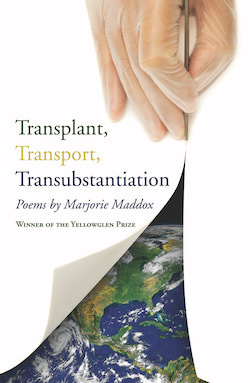
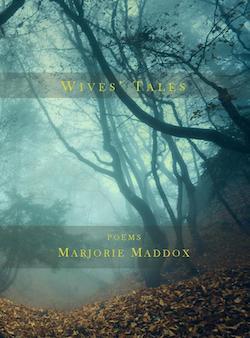


Books
Transplant, Transport, Transubstantiation
True, False, None of the Above
Local News from Someplace Else

Dreaming of Stones
Christine Valters Paintner's new collection of poems Dreaming of Stones has just been published by Paraclete Press.
The poems in Dreaming of Stones are about what endures: hope and desire, changing seasons, wild places, love, and the wisdom of mystics. Inspired by the poet's time living in Ireland these readings invite you into deeper ways of seeing the world. They have an incantational quality. Drawing on her commitment as a Benedictine oblate, the poems arise out of a practice of sitting in silence and lectio divina, in which life becomes the holy text.
[image error]




